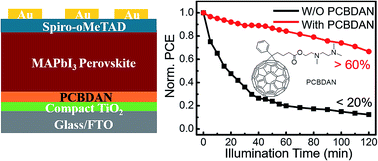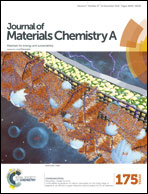Enhanced performance and light soaking stability of planar perovskite solar cells using an amine-based fullerene interfacial modifier†
Abstract
Organic–inorganic lead halide perovskite solar cells (PSCs) with TiO2-based architectures have emerged for highly efficient photovoltaic conversion in recent years, while their serious light soaking instability limits their practical applications. Here, we have successfully introduced fullerene [6,6]-phenyl-C61-butyric acid 2-((2-(dimethylamino)ethyl)(methyl)-amino)-ethyl ester (PCBDAN) as an interfacial modifier for the TiO2 electron transport layer (ETL) in planar PSCs, which can significantly improve the photovoltaic conversion efficiency and light soaking stability of the devices. The quality of the perovskite film and electron extraction efficiency between the perovskite and ETL are both improved by introducing the PCBDAN interfacial layer. An improved power conversion efficiency (PCE) of 16.78% can be obtained for the device with PCBDAN under AM 1.5G illumination (100 mW cm−2). And the light soaking stability of the planar device is greatly improved after modification. This work provides a feasible way by interfacial modification for the realization of highly efficient devices without light-soaking degradation.


 Please wait while we load your content...
Please wait while we load your content...